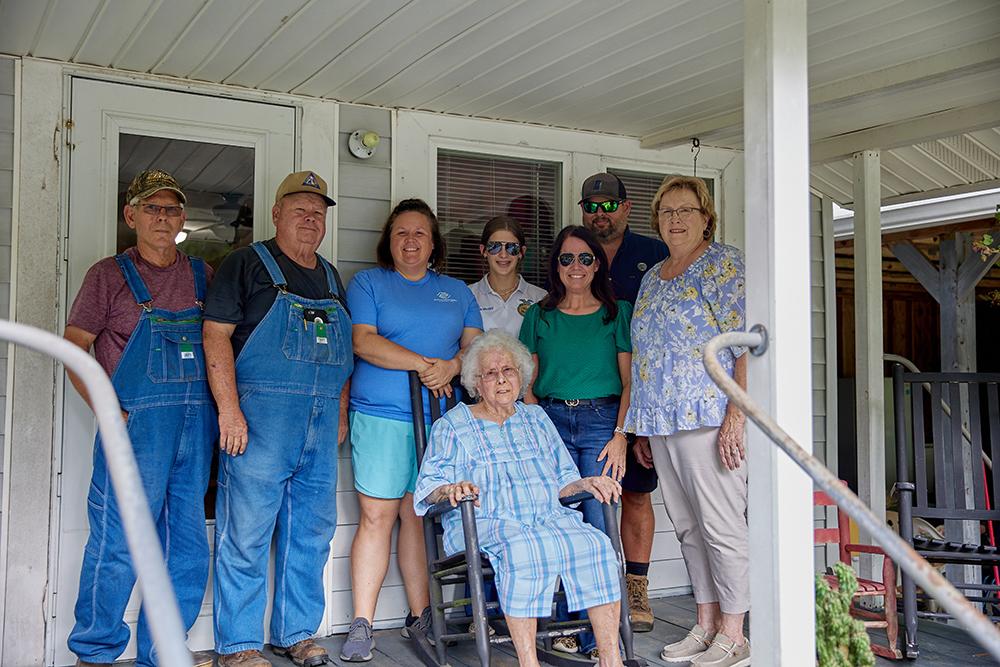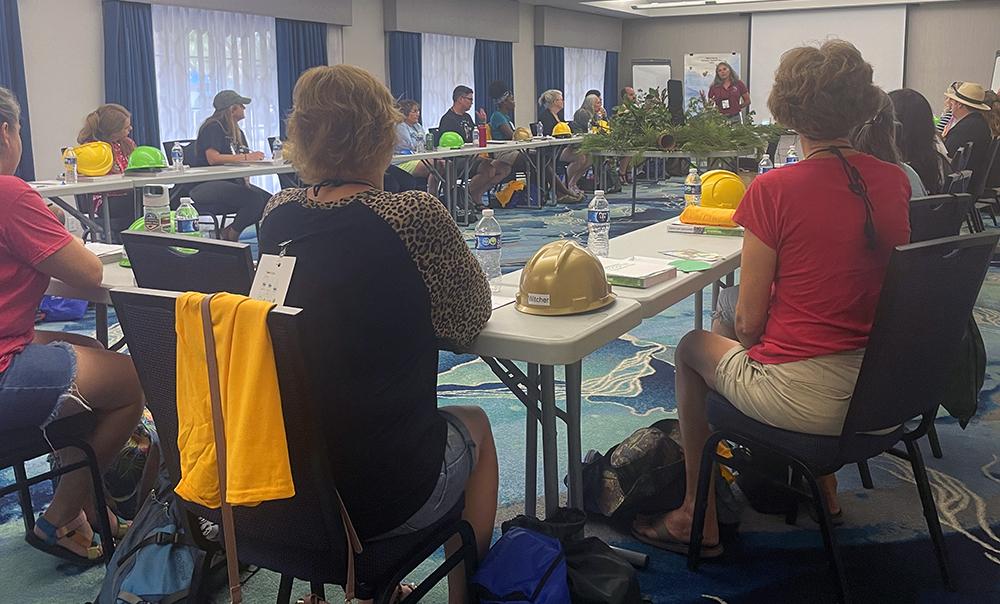Florida Teachers Moved to Tears by Forestry-Focused Tour
The Florida Forestry Teachers’ Tour is an intense, immersive experience that allows teachers to witness the work of professionals across many aspects of the forestry industry.
Published 01-10-24
Submitted by Rayonier
Originally published on Rayonier.com
There is an air reminiscent of the first day of school when 40 strangers sit down in the classroom together for the first time at the Hampton Inn in downtown Fernandina Beach. Instead of doing the teaching, today these school teachers, homeschoolers and one school principal are here to be the students. They have come from all over the state of Florida to learn about the forestry industry.
Some came to the Florida Forestry Teachers’ Tour with goals, wanting to get answers to questions they had about how the industry works; looking to incorporate forest-focused field trips into their curriculum; or wanting to learn about job opportunities to share with their students. Others came unsure what to expect but ready to learn.
By the end of the week, many of these same teachers will be in tears as the tour comes to a close. They will build friendships over long days outdoors. They will meet forestry workers who will change the way they see the world. And, as they will share with one another in a closing discussion, they will finish the week with a new level of respect for the industry that has such a huge impact on their lives—but that they had known so little about. Until now.

Day 1: A forestry legend sets the stage
There’s no one better than Ed Barnard to introduce newcomers to forestry. The retired forest pathologist has served as the tour’s emcee for more than 20 years. He is the first person the teachers meet.
“Prepare yourselves for an extravaganza of experience and exposure to the breadth and depth of the forestry profession,” Ed tells the group as he kicks off a presentation about the industry. “All the way from growing trees to processing trees into logs to creating pulp and paper, chemicals, cellulose, and lumber products. The complete picture and the whole cycle of regeneration, starting it all over again. The process from A to Z.”
Within minutes, it’s clear this isn’t the typical classroom-based continuing education program teachers are used to. In fact, they will be on a bus before 6:30 tomorrow morning, touring key components of the industry until after the sun sets.
And Ed will be there at every step. He’ll ride along with the teachers on the bus each day, answering questions and sharing his own perspective. He will share laughs and pull more than a few good-natured practical jokes. There’s also a good chance that, by the end of the week, he’ll fight back tears right alongside the teachers as they share how the tour has changed their perspectives.

Day 2: A mill, a burn, and a family farm
Now donning their forest boots and orange vests, the teachers are ready to experience the forestry industry up close and personal. The day begins in the West Fraser Sawmill in Whitehouse, Florida.
The teachers walk through the mill, watching how logs become lumber in a matter of minutes.
“Nothing goes to waste,” explains General Manager Jerome Worthy, pointing out that even the bark is used to create a mulch product and the sawdust is used in wood pellets.
Later this same morning, the teachers watch as a Florida Forest Service team demonstrates how controlled burns are used as a tool in forestry.
One teacher asks how wild animals fare in a controlled burn.
“If you watch during a burn, you’ll see the wildlife evacuate. Even the bugs! When the burn completes, you’ll see them come right back into that same forest,” a ranger answers.
The bus travels to several more sites before days’ end, giving the teachers a chance to see how the military manages forest land at Camp Blanding Joint Training Center; to see what a teaching forest is like at the University of Florida’s Austin Cary Forest; and to meet a family that has owned and managed the same farm for multiple generations.
“When people ask me what it would take for me to sell this land, I tell them, ‘I remember planting that forest with my grandfather. What price would you put on that?’” Kelly Mosley tells the teachers. “To us, it’s priceless.”

Day 3: Harvesting, sustainable forest management and some shocking revelations
As the sun is rising this morning, the tour bus is pulling into a harvest site so the teachers can see firsthand what happens when it’s time for trees to become products.
Watching as a heavy equipment operator systematically fells trees and sorts them for different logging trucks, the teachers have many questions about what happens during a timber harvest.
“How old are these trees?” “What kind of products will they become?” “When will this forest be replanted?”
Fernandina Beach High School Biology Teacher Angie Kindler writes notes as quickly as she can.
“Something that I had always questioned was a statistic about how many trees they plant to replace the ones that they harvest,” she says. “I got that answer today, so that’s something that I’ll be able to bring back to my students.”
In fact, in sustainable forestry, multiple trees are planted for every tree harvested.
Next, the bus goes deep into the forest for lessons about sustainable forest management led by Rayonier foresters. The group discusses sustainability certification and what it takes to prove a forest is sustainably managed. They talk about the lifecycle of the forest. And they show how foresters protect water quality at every step.
Today also includes a pulp mill tour and a lesson about the incredible ways forest byproducts play a role in scent manufacturing.

Day 4: Reflecting on lessons learned
The tour wraps with a group discussion on the final morning. Everyone gets a chance to share how their perspectives about forestry have changed.
Before long, some are in tears, shocked at how much they didn’t know and ready to incorporate entirely new lessons about forestry into their curricula.
“I think the greatest takeaway for me has been, I didn’t really realize that companies and foresters are way more concerned about the environment than the public,” says Michelle Fisher, a high school biology teacher from Tampa. “The people that we’ve met on this tour, they don’t seem like they’re in it for the money and this kind of stuff. They seem like they’re bigger tree-huggers than I ever thought about being. And I thought I was a pretty big tree-hugger.”
While the tour slightly changes from year to year, it is always action-packed with experiences around many different aspects of forestry. The Florida Forest Service hosts it with support from the Florida Forestry Association, Project Learning Tree of Florida and Friends of Florida State Forests. Dozens of other companies and individuals also sponsor the tour.
To apply to participate in the Florida Forestry Teachers’ Tour, applicants should submit their answers to a questionnaire. A committee then reviews and chooses participants.
To learn more and apply, visit floridastateforests.org/teacherstour.



Rayonier
Rayonier
Rayonier (NYSE:RYN) is a leading timberland real estate investment trust with assets located in some of the most productive softwood timber growing regions in the United States and New Zealand. We own or lease under long-term agreements approximately 2.8 million acres of timberlands located in the U.S. South, U.S. Pacific Northwest and New Zealand. We are More than trees because we recognize that our 90+ years of success in the timberland industry comes from our people, an empowering culture and the courage to constantly challenge “the way it’s always been done.” Get to know us at www.rayonier.com.
More from Rayonier

